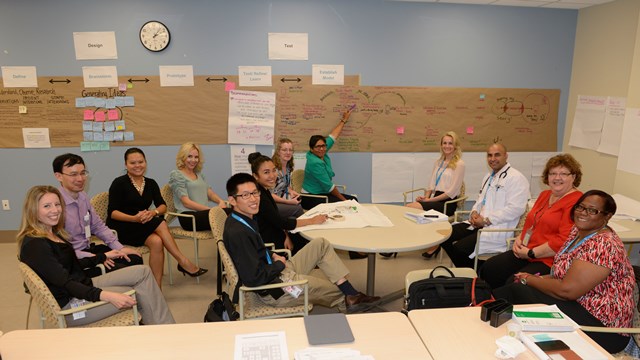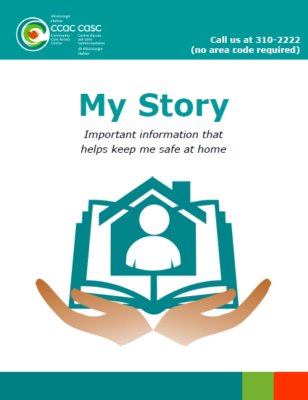
Learnings from the Seamless Transitions: Hospital to Home approach prompted the Mississauga Halton CCAC to develop ‘My Story’ – a personalized information package that helps each patient understand and manage their care at home.
By Avori Cheyne
After slipping on ice and fracturing his hip, Gordon spent five days in hospital. There, he met many members of his care team, but was unsure who to ask about his care instructions. As Gordon packed to leave hospital, his care team members asked him the same questions he had answered many times. Having to repeat his story was frustrating. When he left hospital, he didn’t know how he was going to heal at home or who would help him.
Recognizing stories like Gordon’s were all too common, the Mississauga Halton Community Care Access Centre (CCAC) partnered with Trillium Health Partners (THP) to develop a safer way for patients to leave hospital and return home with less repeated steps or unanswered questions.
The goal was to eliminate process duplications and reduce gaps in care and communication that can put patients at risk. To develop this approach, THP and the Mississauga Halton CCAC formed an interdisciplinary team. They gathered feedback from their staff, physicians, community providers, a leading practice review, patients and families. Informed by these insights, they developed Seamless Transitions: Hospital to Home, a consistent, integrated approach to improve patients’ experiences as they transition from hospital back to home and their community.
For patients like Gordon, this approach would mean meeting his care team members early in his hospital stay and learning how each contributes to his care. This team would meet daily to discuss his care and eventual discharge. And his care team would be consistent throughout his hospitalization, with one person, a Transition Coordinator, liaising between him and the other team members.
All members of Gordon’s care team would also update and have access to his Story – a written, plain language summary of his care needs and plan. Gordon would know who to ask for help and didn’t need to repeat information.
Before leaving hospital, Gordon’s My Story information would be sent to his family physician and local pharmacist. His Transition Coordinator would book his follow-up doctor’s appointments, and connect with his CCAC community care coordinator to ensure his care plan was in place.
Following 500 patients like Gordon from admission through to discharge and recovery at home, the Seamless Transitions team tested the approach for nine months in the THP-Credit Valley Hospital Medicine program.
Significant results occurred. On average, patients were discharged almost one day sooner, their satisfaction increased and their hospital readmissions 30 days after discharge dropped by 52 per cent.
Patients and families, who experienced Seamless Transitions said, “I did not feel like I was left out …. There was a team approach – everyone was talking to one another. The discharge booklet was great. I left knowing what I was doing – everything was explained. … I can just bring the booklet to appointments. You really put the ‘care’ back in healthcare.”
Physicians, who were members of the interdisciplinary test teams, remarked: “Our patients are discharged sooner, the process is much smoother, and I feel like part of the team. There are less handovers and duplications because we are always connected.”
Other care team members, such as social workers, nurses, therapists and CCAC care coordinators, also supported the approach, noting My Story as “one source of truth” for patient information and daily discharge rounds to facilitate team building and timely solutions for barriers to discharge.
With these results, the Ontario Association of Community Care Access Centres (OACCAC) recognized Seamless Transitions with the 2016 Sector Innovation Award for Partnering with Quality at the provincial association’s Awards of Excellence this past June. The award acknowledged the efforts of a sector team that has demonstrated outstanding, innovative leadership in developing and implementing initiatives driven from sector-shared purpose and priorities.

Locally, this approach has since been tested at Halton Healthcare, to serve as a regional standard. And learnings from it have informed the Mississauga Halton CCAC’s ‘My Story’ patient information package, which includes plain language, patient-centred care planning tools focused on achieving goals set by the patient and their family. Its patients receive this package before leaving hospital to help them understand and manage their care at home. It also includes information for carers who help support loved ones, who have complex medical needs but want to remain at home.
You can learn more about Seamless Transitions in the project’s Guidebook, which outlines the partnership and design process. It also serves as a blueprint to help other hospital and community organizations implement new models of transition planning and effectively integrate care for their patients. The guidebook and other info can be found at www.healthcareathome.ca
Avori Cheyne is a Communications Strategist at the Mississauga Halton CCAC.

